May itinerary in Japan Day 1 (Kumamoto Meal edition)
(Tuesday, May 17)
Table of contents
1. Uemura Unagiya (Eel restaurant)
1. Uemura Unagiya (Eel restaurant)
The first meal of this trip to Kumamoto was at “Uemura Unagiya“. “Uemura Unagiya” is a long-established eel restaurant that was founded in 1908 and has a history of more than 100 years. It has also been selected as one of the “100 famous tabelog restaurants”. It is the only “100 famous tabelog restaurants” in Hitoyoshi City. The restaurant opens at 10 am and the opening time is very early. I entered the restaurant at 11:00 am, but there were already several pairs of customers sitting in their seats.

I ordered “Uzaku (vinegared eel and cucumber)” (Yen 800), “Eel Liver” (Yen 1,000), and “small Unaju (broiled eel served over rice in a lacquered box)” (Yen 3,200) at “Uemura Unagiya”. The taste of “Uzaku” was above average, but the “liver of eel” and “shige of eel” were excellent.
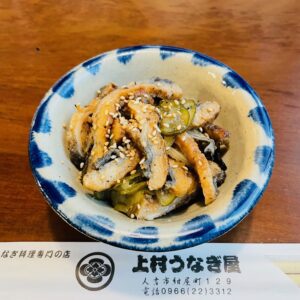
As you can see in the picture, the volume of “eel liver” was as large as 20 eels. I think it’s the first time in my life that I’ve eaten so many eel livers. I love eel liver so I was very happy.

At “Uemura Unagiya”, they swims eels in fresh water for about 5 to 10 days. They cleaned the eels after receiving an order, and grilled over charcoal, and served with a secret sauce. Since eel swam in fresh water, it has no odor. There are many “eel restaurants” in Hitoyoshi City because eels were caught in the Kuma River. There are 5 “eel restaurants” registered in “Tabelog” in Hitoyoshi City alone. At present, the catch of natural eels on the Kuma River has decreased, so it seems that “Uemura Unagiya” uses eels from Kagoshima prefecture.

Around 12:00 when I left “Uemura Unagiya”, there was a line of customers waiting for a seat in the store. It was definitely “Uemura Unagiya” that I saw the most people in Hitoyoshi City.
2. Sengetsu Shuzo
After sightseeing in Hitoyoshi, I had a tasting of rice shochu at Sengetsu Shuzo. Sengetsu Shuzo is a long-established rice shochu maker founded in 1903.
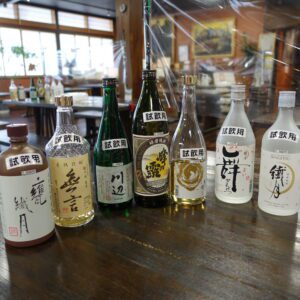
Hitoyoshi City has a history of rice shochu for about 500 years. There seems to be a record in 1546 that Francis Xavier was informed that “people are drinking rice shochu in Japan.” On the other hand, the production of Imo Shochu (spirit distilled from potatoes) has been since 1782. Therefore, the oldest shochu in Japan is rice shochu.
Sagara family, the feudal lord of the Hitoyoshi domain, was actively trading with Southeast Asia and mainland China, and it is said that the introduction of distillation technology was the catalyst for making shochu. There are still 27 shochu breweries in the Hitoyoshi region. Rice shochu produced in the Hitoyoshi Basin is called “Kuma shochu” and has been designated as a protection of the production area label based on the TRIPS Agreement (Agreement on Trade-related Aspects of Intellectual Property Rights) of the World Trade Organization. There are only a few alcoholic beverages that have been designated as protected by the origin label, such as Scotch whiskey and Bordeaux wine, and “Kuma Shochu” is a globally recognized brand.
The biggest difference between rice shochu and sake made from the same rice is “spirits or fermented liquor”. Sake is a “fermented liquor” made by fermenting rice, which is the raw material. On the other hand, rice shochu is a “spirits” that adds a process called distillation to the brewed sake. The alcohol content of rice shochu and sake is also different. The alcohol content is 22 degrees or less for sake and 45 degrees or less for rice shochu.
In the Hitoyoshi Basin, which used to be rice, the warm climate is not suitable for sake brewing, and it is estimated that rice shochu was made instead of sake. As the word “Kan zukuri (cold brewing)” is used in sake, it is said that the most suitable for sake brewing is the cold season from December to February. This is the reason why sake production is low in warm Kyushu and Okinawa.
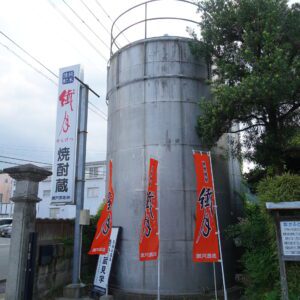
I don’t know if it’s true or false, but the reason why a lot of rice shochu was produced in the Hitoyoshi Basin is that the Hitoyoshi domain avoided the inspection of the shogunate, and the actual rice production is much higher than the nominal rice production. It is said that this is because it was possible to make rice shochu. The rice production of the Hitoyoshi domain was 22,000 koku, but it seems that it was actually 100,000 koku. It is said that this is because the Hitoyoshi basin is a gourd-shaped basin, and a wide basin spreads further into the land where the shogunate’s inspection is conducted to produce rice. Therefore, rice shochu could be produced from the surplus rice of the Hitoyoshi clan, but other clan in Kyushu produced shochu using sake lees called “Kasutori shochu”. I also heard these stories from the locals twice on this trip to Hitoyoshi.
In this way, the history is long and the intensity of feelings to rice shochu in the Hitoyoshi Basin are strong. Rice shochu is dedicated at Aoi Aso Shrine, a national treasure.
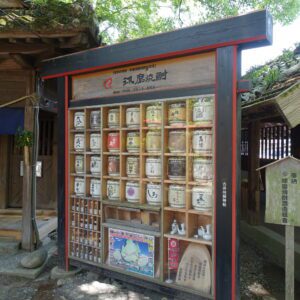
Let’s return to the tasting of Sengetsu Shuzo. At Sengetsu Shuzo, we can sample about 20 types of rice shochu for free. There was also a rice shochu that tasted completely different from the rice shochu I had ever drank, and I made various discoveries. There was also an episode in which professional skier Yuichiro Miura liked Sengetsu Shuzo’s rice shochu and drank rice shochu at the summit of Mt. Everest. Sengetsu Shuzo also sold “Tetsuharu Kawakami Red Bat Shochu”, which was named after Tetsuharu Kawakami of the professional baseball Yomiuri Giants who was from Hitoyoshi City.
I tasted and bought my favorite rice shochu “Mugon” and drank it at “Hitoyoshi Ryokan” at night. The taste and color were so different from the rice shochu I had ever drank that I thought it was whiskey rather than shochu.
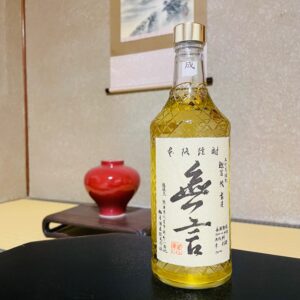
3. Hitoyoshi Ryokan
After enjoying the tasting at Sengetsu Shuzo, I had dinner at the Hitoyoshi Ryokan where I stayed. The dinner at “Hitoyoshi Ryokan” was very satisfying with luxurious meals such as local dishes.
First of all, the appetizer was small bowls that were beautifully presented like “Bamboo shoots and squid with bud dressing” and “Japanese butterbur with white miso”. Everything was delicious, but especially the “Yama-uni (Mountain sea urchin) Tofu”, a local dish of Itsuki Village near Hitoyoshi City, was excellent.

“Slices of Yamame washed in cold water (sashimi)” and “Yamame salt-grilled” were also the best. Yamame is a river-remaining type (land-sealed type) of cherry salmon that spends its entire life in the river. The Yamame is called the “queen of mountain torrent” because of its beauty.

“Taro steamed buns with yuba ankake”, “Chawan-mushi (a savory steamed egg custard with assorted ingredients)”, “Fried bamboo shoots and edible wild plants tempura” were also very delicious. I was very satisfied with my meal so far, and then I had a hot pot dish.



The hot pot dishes were “Black Berkshire pork in Kuma” and “Tamogi Mushroom (golden oyster mushroom)”. “Tamogi mushroom” is a mushroom of the family of Hiratake. It has a bright yellow umbrella and is characterized by being rich in ergothioneine (an antioxidant component) that suppresses aging. “Tamogi mushroom” seems to be eaten in China and Taiwan. In Japan, the main production areas of “Tamogi mushroom” are Hokkaido and Tohoku, but it is also produced in Asagiri Town, Kumamoto Prefecture, near Hitoyoshi City.
A picture named after “SL Hitoyoshi” running between Kumamoto Station and Hitoyoshi Station was drawn on the pot. “SL Hitoyoshi” currently operates only between Kumamoto Station and Tosu Station due to 2020 Kyushu floods.


At the end of the meal, I had “Pot rice with local chicken, mushrooms and thinly deep-fried tofu” and “Tsubon soup”. “Tsubon soup” is a soup with a lot of ingredients such as chicken, kamaboko (boiled fish paste), taro, burdock, carrot, and radish. It is a local dish in the Kuma area, and is also listed in “Our Regional Cuisines” in Kumamoto Prefecture, which is selected by the Ministry of Agriculture, Forestry and Fisheries. Both “Pot rice” and “Tsubon soup” were very delicious dishes.


The dessert was “Pear sorbet and Kuma chestnut Mont Blanc monaka”. I thought this dessert was of such high quality that it would be quite talked about if it was sold at a cake shop or cafe. It was really excellent.

All the dishes at “Hitoyoshi Ryokan” were delicious and I left the dinner venue with great satisfaction. Also, at the dinner at “Hitoyoshi Ryokan”, the “Okami (landladies)” greeted each table, and the maids also provided a friendly and pleasant service, which made me feel at ease.
“Hitoyoshi Ryokan” is a national registered tangible cultural property inn. “Hitoyoshi Ryokan” was severely damaged by 2020 Kyushu floods, but it was completely restored and the entire building was reopened in May this year. It was good to see the power of reconstruction of “Hitoyoshi Ryokan” without any trace of disaster now.
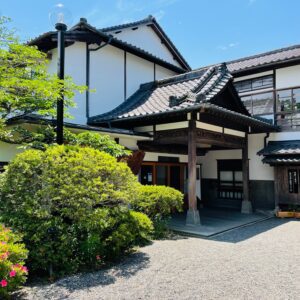
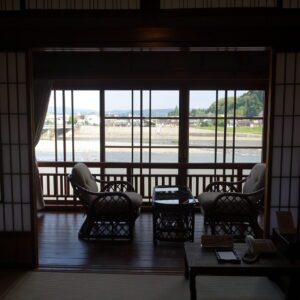
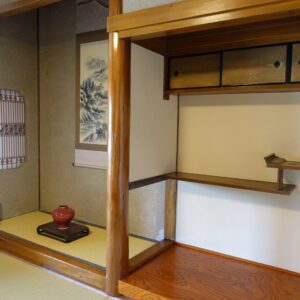
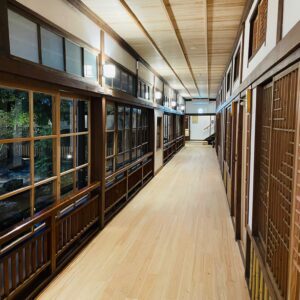
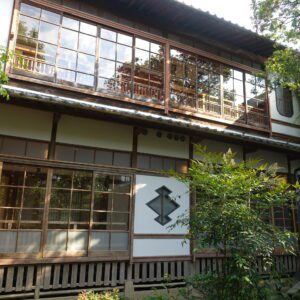
Note: The departure / arrival times, fares, admission fees of transportation, meal fees, etc. listed in the text are as of the time of writing the BLOG. Please check for yourself when you go on a trip as it may change in the future.
